Fibrin, γ'-fibrinogen, and transclot pressure gradient control hemostatic clot growth during human blood flow over a collagen/tissue factor wound
- PMID: 25614284
- PMCID: PMC4344417
- DOI: 10.1161/ATVBAHA.114.305054
Fibrin, γ'-fibrinogen, and transclot pressure gradient control hemostatic clot growth during human blood flow over a collagen/tissue factor wound
Abstract
Objective: Biological and physical factors interact to modulate blood response in a wounded vessel, resulting in a hemostatic clot or an occlusive thrombus. Flow and pressure differential (ΔP) across the wound from the lumen to the extravascular compartment may impact hemostasis and the observed core/shell architecture. We examined physical and biological factors responsible for regulating thrombin-mediated clot growth.
Approach and results: Using factor XIIa-inhibited human whole blood perfused in a microfluidic device over collagen/tissue factor at controlled wall shear rate and ΔP, we found thrombin to be highly localized in the P-selectin(+) core of hemostatic clots. Increasing ΔP from 9 to 29 mm Hg (wall shear rate=400 s(-1)) reduced P-selectin(+) core size and total clot size because of enhanced extravasation of thrombin. Blockade of fibrin polymerization with 5 mmol/L Gly-Pro-Arg-Pro dysregulated hemostasis by enhancing both P-selectin(+) core size and clot size at 400 s(-1) (20 mm Hg). For whole-blood flow (no Gly-Pro-Arg-Pro), the thickness of the P-selectin-negative shell was reduced under arterial conditions (2000 s(-1), 20 mm Hg). Consistent with the antithrombin-1 activity of fibrin implicated with Gly-Pro-Arg-Pro, anti-γ'-fibrinogen antibody enhanced core-localized thrombin, core size, and overall clot size, especially at venous (100 s(-1)) but not arterial wall shear rates (2000 s(-1)). Pathological shear (15 000 s(-1)) and Gly-Pro-Arg-Pro synergized to exacerbate clot growth.
Conclusions: Hemostatic clotting was dependent on core-localized thrombin that (1) triggered platelet P-selectin display and (2) was highly regulated by fibrin and the transclot ΔP. Also, γ'-fibrinogen had a role in venous but not arterial conditions.
Keywords: fibrin; hemodynamics; hemostasis; thrombin.
© 2015 American Heart Association, Inc.
Figures
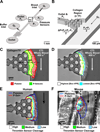
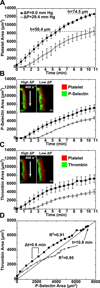
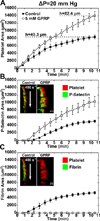
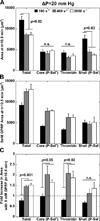
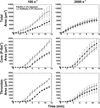



Similar articles
-
Establishing the Transient Mass Balance of Thrombosis: From Tissue Factor to Thrombin to Fibrin Under Venous Flow.Arterioscler Thromb Vasc Biol. 2018 Jul;38(7):1528-1536. doi: 10.1161/ATVBAHA.118.310906. Epub 2018 May 3. Arterioscler Thromb Vasc Biol. 2018. PMID: 29724819 Free PMC article.
-
Thrombus growth and embolism on tissue factor-bearing collagen surfaces under flow: role of thrombin with and without fibrin.Arterioscler Thromb Vasc Biol. 2012 Jun;32(6):1466-76. doi: 10.1161/ATVBAHA.112.249789. Epub 2012 Apr 19. Arterioscler Thromb Vasc Biol. 2012. PMID: 22516070 Free PMC article.
-
Flow and delta-P dictate where thrombin, fibrin, and von Willebrand Factor will be found.Thromb Res. 2016 May;141 Suppl 2:S22-4. doi: 10.1016/S0049-3848(16)30357-7. Thromb Res. 2016. PMID: 27207416
-
Transport physics and biorheology in the setting of hemostasis and thrombosis.J Thromb Haemost. 2016 May;14(5):906-17. doi: 10.1111/jth.13280. Epub 2016 Mar 30. J Thromb Haemost. 2016. PMID: 26848552 Free PMC article. Review.
-
The effects of arterial flow on platelet activation, thrombus growth, and stabilization.Cardiovasc Res. 2013 Jul 15;99(2):342-52. doi: 10.1093/cvr/cvt110. Epub 2013 May 10. Cardiovasc Res. 2013. PMID: 23667186 Review.
Cited by
-
Reduced model to predict thrombin and fibrin during thrombosis on collagen/tissue factor under venous flow: Roles of γ'-fibrin and factor XIa.PLoS Comput Biol. 2019 Aug 5;15(8):e1007266. doi: 10.1371/journal.pcbi.1007266. eCollection 2019 Aug. PLoS Comput Biol. 2019. PMID: 31381558 Free PMC article.
-
Contact Pathway Function During Human Whole Blood Clotting on Procoagulant Surfaces.Front Med (Lausanne). 2018 Jul 23;5:209. doi: 10.3389/fmed.2018.00209. eCollection 2018. Front Med (Lausanne). 2018. PMID: 30083534 Free PMC article. Review.
-
Establishing the Transient Mass Balance of Thrombosis: From Tissue Factor to Thrombin to Fibrin Under Venous Flow.Arterioscler Thromb Vasc Biol. 2018 Jul;38(7):1528-1536. doi: 10.1161/ATVBAHA.118.310906. Epub 2018 May 3. Arterioscler Thromb Vasc Biol. 2018. PMID: 29724819 Free PMC article.
-
Fibrinogen and Fibrin in Hemostasis and Thrombosis.Arterioscler Thromb Vasc Biol. 2017 Mar;37(3):e13-e21. doi: 10.1161/ATVBAHA.117.308564. Arterioscler Thromb Vasc Biol. 2017. PMID: 28228446 Free PMC article. Review. No abstract available.
-
Impact of Tissue Factor Localization on Blood Clot Structure and Resistance under Venous Shear.Biophys J. 2018 Feb 27;114(4):978-991. doi: 10.1016/j.bpj.2017.12.034. Biophys J. 2018. PMID: 29490257 Free PMC article.
References
Publication types
MeSH terms
Substances
Grants and funding
LinkOut - more resources
Full Text Sources
Other Literature Sources
Medical
Miscellaneous

